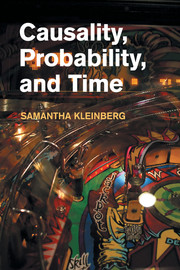4 - Defining Causality
Published online by Cambridge University Press: 05 December 2012
Summary
Preliminaries
The first few chapters of the book reviewed causality (highlighting some primary approaches to reasoning about and inferring it), probability, and logic, so that readers without expertise in these areas could follow the later discussions. The remainder of the book is devoted to developing a new approach that builds on probabilistic causality and temporal logic to infer complex causal relationships from data and explain the occurrence of actual events (called token causality, and the subject of chapter 6). The first task is to determine exactly what causes will be inferred and how these fit in with other theories of causality and causal inference. This chapter will focus on conceptual differences, while chapter 7 contains experimental comparisons against other inference methods. When discussing causality or causal inference, it is important to be precise about the meaning ascribed to the term “causal.” Many fields (including epidemiology, biology, economics, and politics) have developed their own criteria and conventions for what evidence is needed to substantiate a causal relationship. It is common to draw causal conclusions in biology from few experiments where a gene is suppressed (knocked-out) and one tests whether a given observable trait (phenotype) is present in the absence of the knocked-out gene. When the trait is absent the usual explanation is that the gene causes it, but this does not mean it is the sole cause (it may be only one of a set of necessary conditions) nor does it mean that the presence of the trait indicates noncausality.
Information
- Type
- Chapter
- Information
- Causality, Probability, and Time , pp. 65 - 110Publisher: Cambridge University PressPrint publication year: 2012
